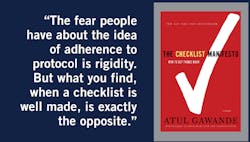How to utilize checklists to improve your maintenance program
Next up on the Plant Services Reliable Reading list is a book about the power of checklists, "The Checklist Manifesto" by Atul Gawande. This book is woven together with brilliantly written anecdotes and in-depth research, and here I’ll share some of my favorites. Can you see how they relate to our industry?
Looking for other great content to read? Reliable Reading will review stellar books on the maintenance and reliability industry, leadership and management practices, and anything that relates to professionals in our industry.
Why do expert professionals even need checklists?
Two philosophers in the 1970s, Samuel Gorovitz and Alasdair MacIntyre, published an essay on the nature of human fallibility. They concluded that sometimes we fail because we want to do something that is beyond our capacity. But even where that capacity is within our reach, sometimes we still fail for two reasons, the philosophers said: ignorance (we don’t have the needed knowledge to perform a certain task) or ineptitude (we have the knowledge but fail to apply it properly).
Gawande, a practicing surgeon, argues that medicine has become so complex (the World Health Organization’s classifications of diseases top more than 13,000, and clinicians have some 4,000 medical or surgical procedures to choose from) that the medical industry has become super-specialized to handle this complexity. Specialists not only have a breadth and quantity of knowledge, but also reliable and precise execution. Yet despite the super-specialists, surgery remains risky. In his search to improve surgical procedures with WHO, Gawande turned to other industries, which also dealt with complexity.
In October 1935, the U.S. Army Air Corps held a flight competition for airline manufacturers to build the military’s next-generation long-range bomber, led by Boeing Corporation’s aluminum-alloy Model 299. It carried more bombs and could fly faster and twice as far as previous bombers. Initially, it appeared not to be much of a competition, until a small group gathered as the Model 299 test plane taxied on the runway and climbed sharply to 300 feet, then stalled and crashed in a fiery explosion. The new plane was substantially more complicated to fly than previous aircraft, and the crash was due to simple error by a very experienced pilot. Deemed “too much airplane for one man to fly,” the Army Air Corps chose the smaller design, and Boeing nearly went bankrupt.
Still, the army purchased a few of the aircraft from Boeing as test planes. Some were still convinced the planes were flyable. How would they manage this new complex plane? You probably guessed it. They created a pilot’s checklist.
“Faulty memory and distraction are a particular danger in what engineers call all-or-nothing processes,” Gawande said, “if you miss just one key thing, you might as well not have made the effort at all.” (I hope your reliability and maintenance senses are starting to tingle.) “Checklists seem to provide protection against such failures. They remind us of the minimum necessary steps and make them explicit,” Gawande says.
Eventually, he travels to Seattle to tour the Boeing Company and talk with the man that spent two decades developing checklists and flight deck controls for Boeing aircraft. He clearly explained to Gawande the difference between a good and a bad checklist. Bad checklists: vague. Good checklists: precise. “They do not try to spell out everything—a checklist cannot fly a plane. Instead, they provide reminders of only the most critical and important steps—the ones that even the highly skilled professionals using them could miss,” Gawande recalls.
The power of the checklist is also limited. “They can help experts remember how to manage a complex process or configure a complex machine. They can make priorities clearer and prompt people to function better as a team,” Gawande writes. Boorman had other good checklist suggestions, such as not too lengthy and make sure it was tested in the real world (he even had a specific suggested font for the checklists), but it was the team function aspect of the checklist that would prove most insightful to Gawande. He would learn that the limit to a checklist’s power is only the participants’ willingness to use them.
Give checklists to those with the least authority
Gawande learned about the extraordinary rescue of a little girl, who had been revived after being dead for more than two hours. In a small Austrian town in the Alps, a three-year-old girl walking with her parents fell into an icy fishpond. She was lost beneath the surface for 30 minutes before they found her at the bottom. The parents began CPR and rescue personnel arrived eight minutes later. The girl had no blood pressure or pulse or sign of breathing. They continued CPR, and helicopter took her to the nearest hospital, where a surgical team put her on a heart-lung bypass machine and began warming her. At the two-hour mark from the time of transport, her heart began to beat again. Ultimately, she made a full recovery.
Gawande was especially intrigued by the case because it happened not at a large cutting-edge academic medical center, but an ordinary community hospital. In talking with the surgeon who wrote the case report, he said the girl had not been the first person they had tried to revive. The hospital received between three to five avalanche or drowning victims a year, each of which required complicated procedures and experts in timely fashion to survive.
So what did he do? Of course, he made a checklist. And who did he give the checklist to? “They gave the checklist to the people with the least power in the whole process—the rescue squads and the hospital telephone operator—and walked them through the details,” Gawande said. The rescue teams alerted the hospital of the preparations needed, and the telephone operator could notify the personnel needed.
If failure is not an option, communication is the key
Gawande studied other industries that used checklists with great success, like the construction industry. Much like medicine, master builders had been replaced with specialized craftsman by the middle of the 20th century. While watching construction workers erect a new building at the medical center where he worked, Gawande wondered: how did they make sure they were building it correctly? Yep, it was a checklist, what they called a submittal schedule, that kept the project on point.
For building construction, the checklists served two main purposes: it was a succession of day-by-day checks to guide how the building is constructed, and the checks to ensure the knowledge of hundreds of people or more were put to use at the right time. While the former list instructs step-by-step what is needed from each trade to build, inevitably, anomalies happen or problems occur, and the latter list ensures that the project handled problems as a team. The builders trust in the power of communication, Gawande explains, the wisdom of the group. “Man is fallible, but maybe men are less so,” he added.
Gawande saw essentially two different kinds of checklists at the heart of building construction: one was dictating instruction to workers to ensure things are done right (centralized power and decision making), but the second list was entirely different. When confronted with a complex, non-routine problem with difficult or potentially dangerous consequences, Gawande says as the building industry instructs, you push the power of decision making away from the center and to the periphery. “You give people the room to adapt, based on their experience and expertise. All you ask is that they talk to one another and take responsibility,” Gawande said.
Change the culture of silent disengagement
When Gawande finally set out to test the WHO safety surgery checklist in his own operating rooms, he saw some pushback, as other medical professionals questioned the introduction of such a rudimentary tool in something as complex as surgery. It took some encouragement and reminders. Nurses were given the authority to run the checklist and ultimately, clear the patient for surgery. “Even a modest checklist had the effect of distributing power,” Gawande said.
In talking with other medical facilities about their checklist procedures, one of the most important steps remained the communication checks. This involves self-introduction, as many surgical teams don’t always work together, and each member of the team discusses the case together and any of the patient’s unique potentially critical dangers. This works two-fold to help create a new dynamic in operating rooms with checklists: the introductions force everyone to stop and address any issues that may come up during surgery, so they were prepared, and also work to create a team atmosphere. The most common obstacles to effective teams, Gawande writes, “is a kind of silent disengagement, the consequence of specialized technicians sticking narrowly to their domains.”
As a lover of lists, I was disappointed to find out that not everyone loves them as much as I do. Gawande contemplates the many reasons for this, as a question of human’s most basic fears of embarrassment and lack of discipline. However, the bulk of his study and creation of checklists make their usefulness seem easily attainable, the secret key to perfection.
Like surgeons or builders, maintenance and reliability professionals perform complex processes under constantly changing conditions. Highly specialized teams are needed in many cases to be successful, but only when they all work together as a team. Checklists seem like a natural part of any maintenance program. If you’re not using checklists in some fashion, I suggest you give them a try. And if you’re not sure where to start, this book will give you more than a blueprint for how to build a checklist. It will help you discover their power.
This story originally appeared in the February 2022 issue of Plant Services. Subscribe to Plant Services here.
About the Author

Anna Townshend
managing editor
Anna Townshend has been a journalist and editor for almost 20 years. She joined Control Design and Plant Services as managing editor in June 2020. Previously, for more than 10 years, she was the editor of Marina Dock Age and International Dredging Review. In addition to writing and editing thousands of articles in her career, she has been an active speaker on industry panels and presentations, as well as host for the Tool Belt and Control Intelligence podcasts. Email her at [email protected].

